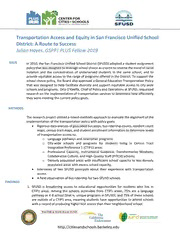
ERIC ED609142: Transportation Access and Equity in San Francisco Unified School District: A Route to Success PDF
Preview ERIC ED609142: Transportation Access and Equity in San Francisco Unified School District: A Route to Success
Transportation Access and Equity in San Francisco Unified School District: A Route to Success Julian Hayes, GSPP| PLUS Fellow 2019 ISSUE In 2010, the San Francisco Unified School District (SFUSD) adopted a student assignment policy that was designed to leverage school choice as a tactic to reverse the trend of racial isolation and the concentration of underserved students in the same school, and to provide equitable access to the range of programs offered in the District. To support the school choice policy, the Board also approved a General Education Transportation Policy that was designed to help facilitate diversity and support equitable access to city-wide schools and programs. Orla O’Keeffe, Chief of Policy and Operations at SFUSD, requested research on the implementation of transportation services to determine how effectively they were meeting the current policy goals. METHODS The research project utilized a mixed-methods approach to evaluate the alignment of the implementation of the transportation policy with policy goals: Rigorous data analysis of geocoded bus stops, bus ridership counts, resident count maps, census tract maps, and student enrollment information to determine levels of transportation access to: o Language pathways and newcomer programs o City-wide schools and programs for students living in Census Tract Integration Preference 1 (CTIP1) areas o Professional Capacity, Instructional Guidance, Transformative Mindsets, Collaborative Culture, and High-Quality Staff (PITCH) schools; o Densely populated areas with insufficient school capacity to less densely populated areas with excess school capacity. Interviews of two SFUSD principals about their experience with transportation access A field observation of bus ridership for two SFUSD schools FINDINGS 1. SFUSD is broadening access to educational opportunities for students who live in CTIP1 areas. Among the schools accessible from CTIP1 areas, 75% are a language pathway or K-8 school (that is, unique programs in SFUSD), and 75% of these schools are outside of a CTIP1 area, meaning students have opportunities to attend schools with a record of producing higher test scores than their neighborhood school. http://citiesandschools.berkeley.edu 2. SFUSD is offering transportation to historically underserved PITCH schools, and schools located in CTIP1 areas: 48% of all bus routes take students to PITCH schools and CTIP1 areas (located primarily in the Mission, Bayview, and Hunter’s Point neighborhoods). By offering transportation to these schools, SFUSD has created a mechanism to improve enrollment—but there is insufficient data to analyze the extent that this strategy has increased enrollment 3. There is transportation to most, but not all, elementary and middle school language pathways and newcomer programs. Currently, SFUSD has transportation to 60% of the newcomer programs and 85% of all language pathways. 4. A tension exists in the transportation policy between providing students in CTIP1 areas with access to other schools and boosting enrollment to historically underserved schools. For instance, Malcolm X Elementary, a school in the Bayview neighborhood, has a school capacity of 176 and a resident count of 341. If every child in the Malcolm X attendance area were to attend the school, the school would be over capacity. However, there are 7 bus routes within a 2.5 mile radius of Malcolm X that transport students to elementary schools in other parts of the City. Using capacity to determine policy can be problematic because students in attendance areas with overcapacity schools are incentivized to not attend their neighborhood school. By virtue of being a CTIP1 area, Malcolm X Elementary also has a history of low academic achievement—creating an additional incentive for students to attend schools in other parts of San Francisco. The result is Bayview neighborhood schools, like Malcolm X Elementary, remain under-enrolled despite the multiple bus routes assigned to them. RECOMMENDATIONS In order for SFUSD further evaluate the impact of the transportation policy and to align policy implementation with equitable outcomes, it should: 1. Ascertain an accurate count for bus ridership by conducting multiple point-in-time counts of students riding the bus. Without this data, it is difficult to make definitive conclusions about the impact of transportation policy on student behavior. 2. Interview parents and administrators to understand the obstacles and barriers facing students and families with respect to transportation access, especially in the Bayview. 3. Create concrete equity metrics and goals to assess the impact transportation has on educational opportunity. 4. Resolve the tension in the transportation policy by adjusting incentives for students to either attend a neighborhood school or city-wide program in the city. http://citiesandschools.berkeley.edu
